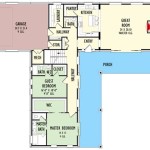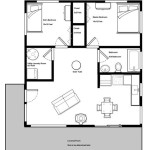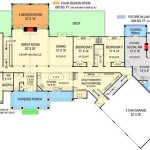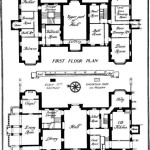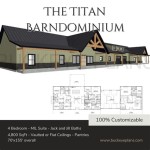Exploring the Appeal of Small One-Story Floor Plans
Small one-story floor plans, often representing an investment in efficiency and accessibility, have become increasingly popular across diverse demographics. These designs cater to individuals and families seeking streamlined living, ease of maintenance, and a connection with the surrounding environment. Their appeal lies in their adaptability and affordability, making them an attractive option for first-time homebuyers, retirees, and those looking to downsize.
The core concept of a small one-story floor plan revolves around maximizing usable space within a limited footprint. This necessitates meticulous planning and a focus on multi-functional areas. Efficient circulation patterns are crucial, minimizing hallway space and prioritizing open-concept designs where appropriate. The design process often involves careful consideration of storage solutions, built-in features, and strategic placement of windows to optimize natural light.
The financial advantages of small one-story homes are significant. Reduced construction costs stemming from a smaller footprint and simplified building processes translate to lower mortgage payments. Furthermore, ongoing maintenance expenses are generally lower due to the smaller roof area, fewer exterior walls, and readily accessible systems. Energy efficiency is also easier to achieve in a compact, single-level structure, leading to reduced utility bills.
Accessibility is a primary advantage of one-story living. The absence of stairs eliminates a significant barrier for individuals with mobility challenges, making these homes ideal for aging in place. Additionally, a single-level design facilitates easier movement for young children and those with physical limitations. This inherent accessibility enhances the long-term livability and adaptability of the home.
Beyond practical considerations, small one-story homes can offer a strong connection to the outdoors. Expansive windows, sliding glass doors, and strategically placed patios or decks blur the lines between indoor and outdoor living. This connection to nature can enhance well-being and create a sense of spaciousness, even within a compact interior.
Cost-Effectiveness and Affordability
The initial investment in a small one-story home is typically lower than that of a larger, multi-story structure. This is due to several factors, including reduced foundation costs, simplified framing, and lower material requirements. The smaller footprint also translates to lower land costs in some areas, further contributing to overall affordability.
The streamlined construction process associated with one-story homes often results in faster build times, reducing labor costs and minimizing delays. This can be particularly advantageous for individuals looking to move into their new home quickly. Furthermore, the simplicity of the design allows for greater flexibility in terms of customization and material selection, enabling homeowners to tailor the home to their specific needs and budget.
Ongoing expenses associated with small one-story homes are generally lower than those of larger homes. Property taxes are often lower due to the smaller assessed value, and homeowners insurance premiums may also be reduced. Energy efficiency is typically easier to achieve in a well-designed one-story home, leading to lower heating and cooling costs. The smaller roof area and fewer exterior walls reduce the potential for maintenance issues and associated repair costs.
The cumulative effect of these cost savings can be substantial over the lifespan of the home. Reduced mortgage payments, lower property taxes, lower insurance premiums, and lower utility bills all contribute to a more affordable and sustainable lifestyle. This makes small one-story homes an attractive option for individuals and families seeking to minimize their financial burden.
Enhanced Accessibility and Universal Design Principles
The absence of stairs is a defining characteristic of one-story homes, making them inherently more accessible than multi-story dwellings. This is particularly beneficial for individuals with mobility limitations, such as those using wheelchairs, walkers, or canes. A single-level design eliminates a significant physical barrier, allowing for greater independence and ease of movement within the home.
Universal design principles can be seamlessly integrated into small one-story floor plans to further enhance accessibility and usability for people of all ages and abilities. These principles focus on creating spaces that are adaptable, safe, and convenient for everyone. Examples include incorporating wider doorways, lever handles, roll-in showers, and adjustable countertops.
Accessible design features can be subtly incorporated into the home without sacrificing aesthetics. Thoughtful planning and careful selection of materials can create a stylish and functional space that meets the needs of all occupants. For example, strategically placed grab bars in bathrooms can provide support without being visually obtrusive, and ramps can be seamlessly integrated into walkways to provide a smooth transition.
The long-term benefits of accessible design are significant. These features not only enhance the livability of the home for individuals with mobility challenges but also provide added convenience and safety for everyone. As homeowners age, accessible design features can become increasingly valuable, allowing them to remain in their homes longer and maintain their independence.
Optimizing Space and Functionality
Successful small one-story floor plans prioritize efficient use of space. This often involves open-concept designs that combine living, dining, and kitchen areas into a single, multi-functional space. This layout maximizes natural light and creates a sense of spaciousness, even within a compact footprint.
Thoughtful storage solutions are essential in small homes. Built-in features, such as shelving, cabinets, and drawers, can maximize vertical space and minimize clutter. Multi-functional furniture, such as sofa beds and storage ottomans, can also help to optimize space and provide flexible living options.
Strategic placement of windows and doors is crucial for maximizing natural light and ventilation. Large windows and sliding glass doors can create a connection to the outdoors and blur the lines between indoor and outdoor living. Skylights can also be used to bring natural light into interior spaces that do not have access to exterior walls.
The layout of the home should be carefully considered to ensure efficient circulation patterns. Hallways should be minimized to maximize usable square footage. Traffic flow should be planned to avoid bottlenecks and ensure easy movement between different areas of the home. The overall design should be intuitive and user-friendly, making the home comfortable and functional for everyday living.
In conclusion, small one-story floor plans offer a compelling combination of affordability, accessibility, and efficient design. Their adaptability and connection to the outdoors make them an attractive option for a wide range of homeowners seeking a streamlined and sustainable lifestyle.

House Plan 49119 One Story Style With 1 Bed Bath

48 Ideas House Plans One Story Country Front Elevation For 2024 C83

One Story Small House Plans

House Plan 45185 One Story Style With 691 Sq Ft 1 Bed Bath

Stylish One Story House Plans Blog Eplans Com

Brilliant Future House Plan One Story Modern Small Home Design Mm 749

Unique One Story House Plans Monster

One Story House Plans Single Floor Design

Best One Story House Plans And Ranch Style Designs

Small One Story 2 Bedroom Retirement House Plans Houseplans Blog Com

